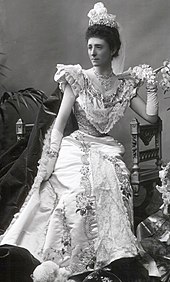Mary Russell, Duchess of Bedford
Mary Russell, Duchess of Bedford (born September 26, 1865 in Stockbridge , † probably on March 22, 1937 in the North Sea ) was an English pilot and ornithologist . She was the wife of Herbrand Arthur Russell, the 11th Duke of Bedford (1858-1940).
Life
Mary Du Caurroy Tribe was born to Walter Harry Tribe, who became the Anglican Archbishop of Lahore . In India in Barrackpore she married on January 31, 1888 Herbrand Russell. His brother died childless in 1888, so that her husband rose to be Duke of Bedford. A son was born on December 21, 1888.
Mary Russell was an avid ornithologist and spent a lot of time on Fair Isle (Shetland Islands) between 1909 and 1914 , together with the future President of the British Ornithological Association , William Eagle Clarke. Her ornithological diary was published posthumously.
After the outbreak of World War I , she founded four hospitals - one on the princely estates in 1914 , then others in Woburn . She herself worked there as a nurse and X-ray specialist.
She was also a member of the suffragette movement .
aviation
At the age of 60, she discovered her interest in aviation in the 1920s, primarily to cure her tinnitus - despite this, she later lost her hearing completely. In 1930 the 64-year-old flew solo for the first time. Her most important flights with her private Fokker F.VII , some of which broke records, included:
- Flight from the Thames to the Indus - 13,750 km - together with your pilot and flight instructor Charles Douglas Barnard, summer 1928.
- Flight London - Karachi - London - 20,000 km - with pilot Barnard, August 1929
- Flight London- Cape Town- London - only 10 days each way - with co-pilot Barnard, April 1930.
Even later on, she still loved to fly.
In March 1937, she crashed off the northeast coast of England with a De Havilland DH.60 Moth . Her body could not be recovered.
Honors
She received the rank of Lady Commander of the British Empire in 1928 . In the same year, the passenger ship Duchess of Bedford was named after her.
She also wore the Royal Red Cross , was a member of the Linnaeus Society in London and a knight of the British Order of St. John .
In 1911 the British zoologist Oldfield Thomas named the little striped shrew ( Sorex bedfordiae ) after the Duchess of Bedford, while in the same year he named the Bedford vole ( Proedromys bedfordi ) and the golden takin ( Budorcas bedfordi ) after her husband.
Individual evidence
- ^ Antonius Lux (ed.): Great women of world history. 1000 biographies in words and pictures . Sebastian Lux Verlag , Munich 1963, p. 54.
- ↑ Bo Beolens, Michael Grayson, Michael Watkins: The Eponym Dictionary of Mammals. Johns Hopkins University Press, 2009; P. 34; ISBN 978-0-8018-9304-9 .
| personal data | |
|---|---|
| SURNAME | Russell, Mary, Duchess of Bedford |
| ALTERNATIVE NAMES | Du Caurroy Tribe, Mary (maiden name) |
| BRIEF DESCRIPTION | English pilot and ornithologist |
| DATE OF BIRTH | September 26, 1865 |
| PLACE OF BIRTH | Stockbridge |
| DATE OF DEATH | March 22, 1937 |
| Place of death | North Sea |

